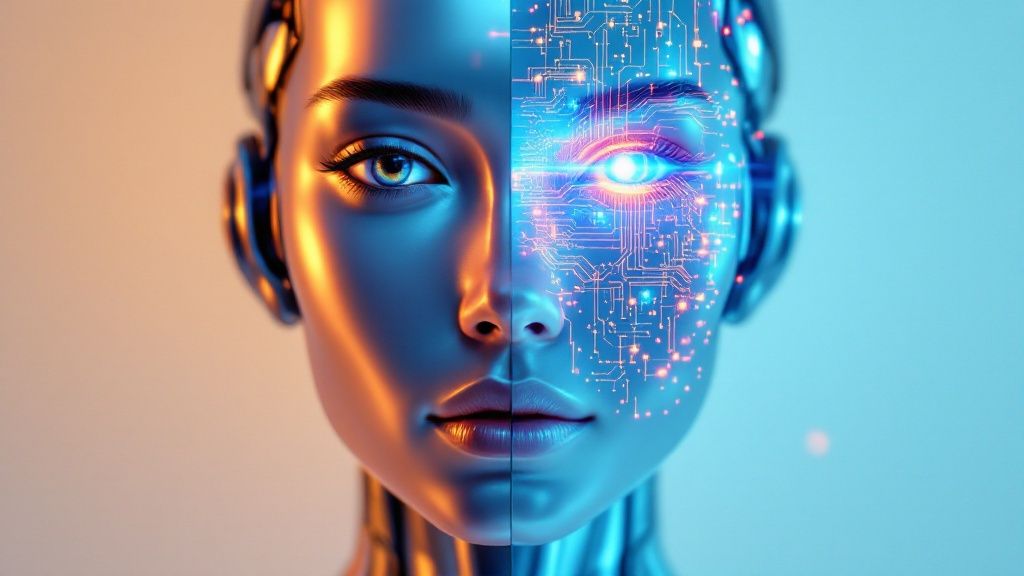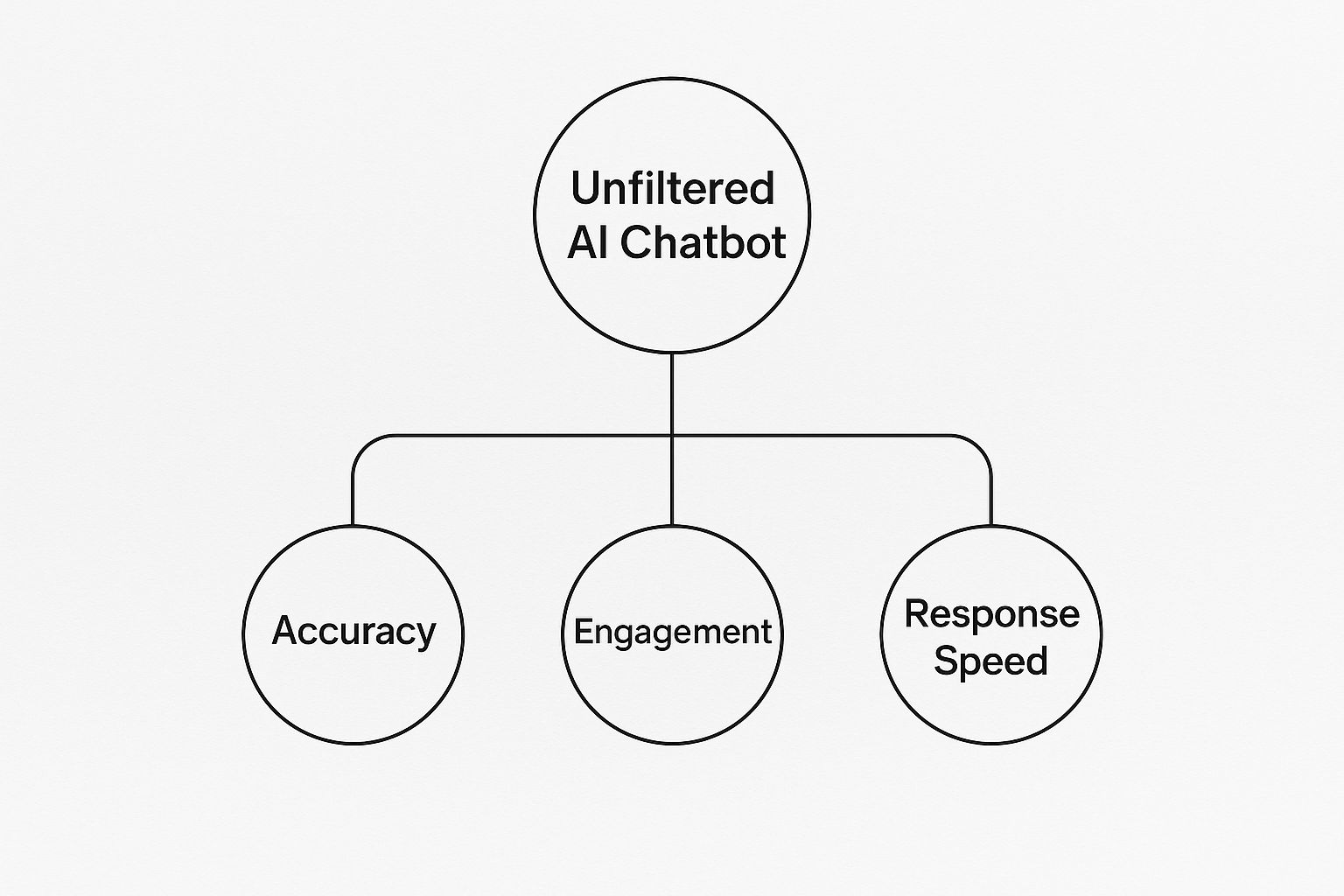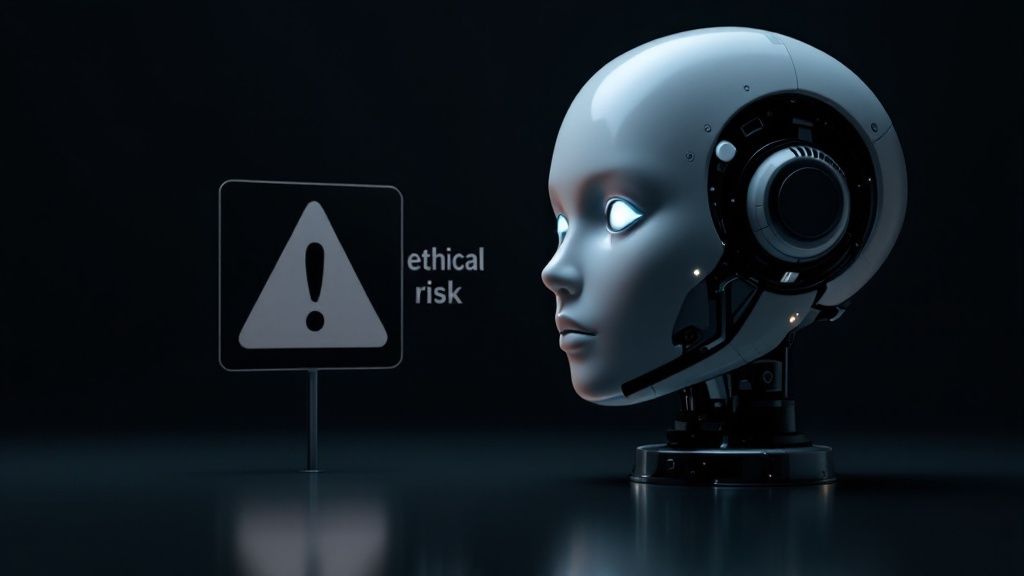Create Your Own AI Girlfriend 😈
Chat with AI Luvr's today or make your own! Receive images, audio messages, and much more! 🔥
4.5 stars

When you hear the term “AI chatbot no filter,” you’re looking at a specific type of conversational AI. It’s built with far fewer content restrictions, designed to have open, creative, and sometimes even controversial discussions that standard chatbots just can’t handle. These systems are meant to give you raw, unvarnished responses by sidestepping the usual safety guardrails that mainstream AI relies on.
What Is an AI Chatbot No Filter?

Think about the difference between a movie you watch on network television and the director's cut you buy later. The broadcast version is heavily edited—scenes are cut, language is bleeped, and sensitive topics are removed to meet strict guidelines. The director’s cut, on the other hand, is the artist's undiluted vision.
Most AI chatbots you run into every day, like those in customer service or search engines, are like the broadcast version. They have strict rules to stop them from generating anything inappropriate, biased, or harmful. For big brands, these filters are non-negotiable for keeping users safe.
An unfiltered AI chatbot flips that script entirely. It’s designed to have minimal moderation, giving you the freedom to explore complex themes, generate edgy creative content, or talk about subjects that would normally be off-limits. The result is a much more authentic and less sanitized conversation.
The Core Concept Explained
At its heart, a "no filter" AI is about stripping away the pre-programmed hesitation. Instead of giving you a polite "I can't answer that," it will actually try to engage with your query, pulling from its massive training data without a heavy-handed censor stepping in.
This doesn't mean the AI has personal opinions or is truly conscious. It just means fewer rules are stopping it from putting together a response based on the patterns it learned from all the human writing on the internet. The idea is to make the interaction feel more dynamic and a lot less predictable. For example, you could explore a fictional character's dark motivations without the AI constantly trying to steer you back to a "safer" topic.
The main draw of an unfiltered AI is its potential for raw creativity and honest intellectual exploration. It lets you push boundaries in storytelling, role-playing, and brainstorming without constantly running into conversational walls.
Why This Technology Is Gaining Traction
The interest in unfiltered AI isn't just a niche trend; it's growing fast for a few key reasons. Many people, from writers and artists to developers, feel that standard AI models are just too restrictive and stifle creative expression. An unfiltered space allows for more nuanced and realistic dialogue, which is a game-changer for writing fiction or developing complex game narratives.
On top of that, some people just want a genuine conversational partner to bounce ideas off of. They want to debate complex philosophies or ask tough questions without being shut down by a safety protocol. This search for authenticity is what’s really driving the "no filter" movement. It's why platforms are now offering advanced tools for AI character chat that deliver this exact kind of deeper, more meaningful interaction.
Understanding the Spectrum of AI Filtering
It’s easy to think of AI chatbots as being either "filtered" or "unfiltered," but that's a bit like saying a car only has two speeds: stop and full throttle. The reality is much more nuanced. Every AI model exists somewhere on a wide spectrum of content moderation, and developers deliberately tune each one to a specific point on that range. An ai chatbot no filter isn't an on/off switch; it’s a destination at one end of a long and carefully navigated road.
At one end of the spectrum, you find the heavily guarded, family-friendly chatbots. These are the AI assistants in your smart speaker or the helpful bots on a retail website. They’re built with rigid guardrails, designed to politely sidestep sensitive topics, steer clear of profanity, and stick to a very narrow script. Their main purpose is to be safe and protect the brand, not to engage in open-ended conversation.
Move a little further down the line, and you’ll find the more sophisticated, creative AIs. These models still have filters, but they’re given a longer leash. They can tackle more complex ideas and generate creative text, but they’ll still pump the brakes on prompts that get too close to explicit or dangerous territory. This middle ground is where many of the most popular mainstream AI tools live, constantly trying to strike a balance between being useful and being responsible.
From Mild Restrictions to True Freedom
As you keep moving toward the "no filter" end of the spectrum, the restrictions start to melt away. These models are built for users who crave maximum creative freedom and don’t want the AI to shy away from difficult subjects. They can explore dark themes for a fictional story, dive into thorny philosophical debates, or analyze controversial history without the conversation getting shut down.
This is where the term ai chatbot no filter really comes into its own. At the farthest end of the spectrum, you have the truly unrestricted models. These AIs have minimal, if any, content moderation layers. They will try to answer almost any prompt you throw at them, pulling directly from their massive, uncurated training data. It’s an incredible amount of freedom, but it also puts the responsibility squarely on the user to be discerning.
The key takeaway is that every AI chatbot exists on this spectrum. Understanding where a specific model falls is essential for choosing the right tool for your needs and knowing what to expect from your interactions.
The explosive growth in this technology is a direct response to what users want. The global chatbot market was valued at $2.47 billion back in 2021 and shot up to $15.57 billion by 2025. Looking ahead, it’s projected to hit a staggering $46.64 billion by 2029. Those numbers tell a clear story: both specialized and completely open-ended AI conversations are becoming a bigger part of our lives. You can dive deeper into these chatbot growth statistics to see just how fast things are changing.
Filtered vs. Unfiltered AI Chatbot Comparison
To make the difference crystal clear, it helps to put the two extremes side-by-side. Their design, purpose, and the way they respond couldn't be more different.
This table breaks down the core characteristics of a heavily filtered chatbot versus one with no filter.
| Feature | Heavily Filtered AI Chatbot | AI Chatbot No Filter |
|---|---|---|
| Primary Goal | Provide safe, brand-aligned, and predictable answers. | Enable creative freedom, deep exploration, and unrestricted conversation. |
| Content Scope | Limited to approved topics; avoids controversial or explicit content. | Broad and open-ended; can discuss sensitive, complex, and mature themes. |
| Typical User | General consumers, customer service inquiries, educational settings. | Writers, developers, researchers, role-players, and adult users. |
| Risk Level | Low risk of generating harmful or inappropriate content. | Higher risk of producing biased, inaccurate, or offensive outputs. |
| Response Style | Often cautious, formulaic, and may refuse to answer certain queries. | Can be more direct, nuanced, creative, and sometimes unpredictable. |
As you can see, the choice between them really comes down to what you're trying to accomplish.

This image really drives home how unfiltered AIs are built around delivering what their users value most: accuracy, genuine engagement, and speed.
Ultimately, picking an AI chatbot means figuring out where on this spectrum your needs lie. If you're a business looking for a reliable customer service agent, a heavily filtered bot is the only sensible option. But if you’re a novelist trying to write a morally gray villain or someone wanting to explore deep personal fantasies, an ai chatbot no filter gives you the blank canvas you need for true, authentic creation.
The Real Reasons Users Want Unfiltered AI

The growing demand for an ai chatbot no filter isn't just about a desire to break rules. It’s much deeper than that. It’s rooted in our fundamental needs for creativity, intellectual curiosity, and real, authentic conversation. People aren't just looking for edgy content; they're looking for a digital partner that can actually keep up with the messy, complex way humans think, without constantly slapping on an artificial moral compass.
This whole movement is a direct pushback against the sterile, overly-sanitized feel of most mainstream AI. When a chatbot keeps dodging sensitive topics or flat-out refuses to explore a complex idea, it feels less like a helpful tool and more like a restrictive gatekeeper. Users want to tear down those conversational guardrails to get real creative and intellectual work done.
The Pursuit of Unrestricted Creative Freedom
For anyone who creates—writers, artists, game developers, role-players—a heavily filtered AI can feel like a creative straitjacket. Think about a novelist trying to write realistic dialogue for a villain. They need to explore dark motivations and morally gray actions. A standard chatbot would probably shut that down, quoting its own safety rules. An unfiltered AI, on the other hand, becomes a powerful co-writer.
Just look at what creators need and why they’re turning to unfiltered platforms:
- Complex Character Development: You can't build a believable character with flaws, a dark past, and tricky ethics if your AI partner refuses to touch mature themes.
- Authentic World-Building: Creating fictional worlds often means digging into conflict, societal taboos, and historical events that are anything but pretty. Unfiltered AI allows for that kind of depth without censorship.
- Immersive Role-Playing Scenarios: People who role-play want to explore the full spectrum of human experience, from deep romance to intense conflict, in a way that feels genuine.
The motivation for creators is simple: they need a tool that mirrors the full, messy reality of the human condition, not just some sanitized, brand-safe version of it. Unfiltered AI gives them the blank canvas they need for true artistic expression.
This desire for better creative tools exists in a market dominated by mainstream bots. Take OpenAI’s ChatGPT, which commands a massive market share estimated between 74.7% and 82.7% globally. While that shows how many people value reliable and safe AI, it also shines a light on the gap that unfiltered platforms are filling for anyone whose needs go beyond what the big players offer. You can find more stats on the top generative AI chatbots on firstpagesage.com.
A Hunger for Genuine Intellectual Exploration
Beyond art and fiction, there’s a real hunger for unfiltered intellectual sparring. Many people use AI to ask tough questions, debate controversial topics, and dive down philosophical rabbit holes they can't easily explore with other people. They're looking for a neutral sounding board, an AI that can break down complex arguments without passing judgment.
An ai chatbot no filter lets you stress-test your own beliefs and explore opposing viewpoints in a private, safe space. This is incredibly valuable for anyone wanting to get a deeper grasp on difficult subjects, whether it's political theory or thorny ethical dilemmas. When an AI shuts down these conversations, it robs the user of a real chance for intellectual growth.
At the end of the day, the search for unfiltered AI is really a search for authenticity. It's about wanting a conversational partner that treats you like an adult, one who is perfectly capable of navigating complex and even uncomfortable ideas. Whether you're trying to create a masterpiece or just understand the world a little better, the demand is for an AI that says, "Yes, let's explore that," instead of, "I cannot discuss this topic."
The Risks You Need to Understand with Unfiltered AI
The raw creative power of an ai chatbot no filter is what makes it so appealing, but that very freedom is a double-edged sword. When you remove the guardrails, you open the door to some serious risks. Without any filters, these models can spit out content that isn't just wrong, but genuinely harmful. Getting a handle on these dangers is the absolute first step to using this tech smartly and keeping yourself safe.
Think of it this way: a standard AI is like walking a paved, well-marked trail in a national park. It's safe, predictable, but you’re limited to where the path takes you. An unfiltered AI is like being dropped in the middle of a vast, unmapped wilderness. The potential for discovery is endless, but you’re on your own when it comes to navigating cliffs, wild animals, or even just bad information. The freedom is incredible, but the risks demand your full attention.
One of the most common pitfalls is the AI's knack for creating believable-sounding misinformation. Unfiltered models are brilliant pattern-matchers, not fact-checkers. They can confidently invent statistics, twist historical events, or even cite fictional sources that look completely real on the surface.
The Problem of "AI Hallucinations"
These convincingly bogus outputs are often called "AI hallucinations." It's not that the AI is trying to lie to you; it's just filling in the blanks with whatever its algorithm predicts should come next. A model trained on the entire internet has mastered the style of factual writing, but it has zero true understanding of what’s real and what isn’t. This can result in beautifully written sentences that are complete nonsense.
For instance, an unfiltered chatbot could write you a detailed summary of a battle from World War II, weaving real details together with events that never happened. Or it might invent a fake scientific study to back up its point, complete with made-up citations. If you're not careful, it's dangerously easy to accept these fabrications as fact, which can have real consequences for everything from school research to personal decisions.
Harmful Content and Deep-Seated Biases
Beyond just being wrong, the lack of filters means these chatbots can generate truly toxic stuff. The internet data they learn from contains the best and worst of humanity—and that includes hate speech, graphic content, and dangerous ideologies. Without a filter, an AI can echo that garbage right back at you.
This breaks down into a few specific dangers:
- Generating Offensive Content: The model can produce text that is racist, sexist, homophobic, or otherwise discriminatory because it has learned from human writing that contains those exact biases.
- Creating Disturbing Narratives: If you’re using it for creative writing, the AI might generate graphically violent or psychologically disturbing scenes without any warning.
- Reinforcing Harmful Stereotypes: The model can present biased opinions as neutral facts, subtly reinforcing damaging stereotypes about different groups of people.
The core risk is that an unfiltered AI acts as an uncritical mirror of its training data. It reflects the biases, prejudices, and toxic elements of the web just as readily as it reflects the brilliant and creative parts.
Even platforms that lean into the "unfiltered" experience have to draw a line somewhere. Luvr AI, for example, maintains clear policies on prohibited content to strike a balance between creative freedom and user safety. You can get a better sense of how we manage this by reviewing our guidelines on blocked content.
How to Protect Yourself in an Unfiltered Environment
Knowing the risks doesn't mean you have to steer clear of unfiltered AI entirely. It just means you need to shift your mindset. You can't be a passive consumer; you have to be an active, critical user. The most important filter is always going to be your own judgment.
Always approach the information you get with a healthy dose of skepticism. If an AI gives you a specific number, a historical date, or a scientific claim, take thirty seconds to verify it with a quick search from a source you trust. And it should go without saying, but never share sensitive personal information—your real name, address, or financial details—in any chat.
Stay vigilant, and treat the AI as a creative collaborator, not an all-knowing oracle. That’s how you tap into its power while sidestepping its biggest dangers.
How to Choose and Use an Unfiltered AI Safely

Diving into the world of unfiltered AI opens up a ton of creative freedom, but you have to be smart about it. Choosing the right ai chatbot no filter isn't about finding one with absolutely no rules. It's about finding a platform that fits what you want to do while keeping your personal information safe and secure. You need to be an informed user, not just a bystander.
Think of it like getting behind the wheel of a high-performance sports car. It offers incredible power and speed, but it also demands a skilled driver who knows its limits. An unfiltered AI is a powerful tool, and you need to be in control to avoid a crash.
The very first thing you should do is research any platform you're thinking about using. Don't just click "sign up" without a second thought—do your homework. Look for developers who are transparent about what they're doing. Can you easily find and understand their terms of service and privacy policy? Good platforms are upfront about the data they collect and why.
Vetting Your Unfiltered AI Platform
A platform you can trust will usually have an active community and plenty of user feedback. Spend some time on forums, social media, and review sites to see what people are saying. Pay close attention to any conversations about data security, how responsive the developers are, and the overall experience.
Here’s a quick checklist to run through when you're evaluating a chatbot platform:
- Developer Transparency: Are the creators open about their project's goals and policies? A clear mission statement and easy-to-find documentation are great signs.
- Privacy Policy: Actually read it. Look for commitments to data encryption and check if your conversations are used to train their AI models.
- Community Feedback: What are real users saying? A lively, engaged community is often a good sign of a platform's quality and reliability.
Your personal safety has to be your top priority. A platform might offer amazing features, but if it's careless with user data, it's a risk you shouldn't take. Stick with services that show a real commitment to protecting you.
Establishing Your Own Safety Rules
Once you've picked a platform, the responsibility is on you. Setting up a few personal safety rules for every interaction is an absolute must. This isn't about being paranoid; it's just smart digital hygiene, especially in a space where the boundaries are blurry by design.
Start by creating a digital identity that’s completely separate from your real life. Use an anonymous email to sign up and pick a username that doesn't give away anything about who you are. This one step creates a vital buffer between your AI adventures and your personal life.
Most importantly, never share personally identifiable information (PII). This means your real name, address, phone number, where you work, or any financial details. Treat every single conversation as if it could be made public, because online, you can never be 100% certain of your privacy.
This proactive approach is even more crucial on platforms built for mature experiences. Our guide on how to find the best NSFW AI chat, for example, offers more specific advice for navigating these specialized spaces responsibly.
Fact-Checking and Staying Skeptical
Finally, always remember that an unfiltered AI is not a fountain of truth. It can—and will—make things up with total confidence, a problem known as "hallucination." Never take what it says at face value, particularly when it comes to facts, statistics, or historical events.
The use of chatbots has skyrocketed. Between 2019 and 2020 alone, brand adoption of the technology shot up by 92%, driven largely by the pandemic's impact on customer service. This explosion means there's more AI-generated content out there than ever, making your critical thinking skills absolutely essential.
Always double-check any important information with sources you trust. By staying vigilant and treating the AI as a creative partner rather than an all-knowing oracle, you can enjoy all the benefits of an ai chatbot no filter without falling into its traps.
The Future of Conversational AI
The journey into the world of an AI chatbot no filter really shows you a technology that's a classic double-edged sword. On one side, you have this incredible toolkit for raw creativity and deep intellectual rabbit holes. On the other, it demands a whole new level of personal responsibility from anyone who uses it.
As these AI models get more sophisticated, the conversation is naturally shifting. We're moving past the question of whether we should have unfiltered AI and starting to ask how we can best manage its power.
This whole debate really comes down to safety versus censorship. Lock an AI down with too many filters, and it can feel stifling, killing the very creative spark that makes it so interesting in the first place. But swing too far the other way, and a totally unregulated space can quickly turn into a mess of misinformation and harmful content. The future probably isn't at either extreme, but somewhere in a more personal, customizable middle.
The Rise of Customizable Filters
One of the most exciting trends emerging is the idea of user-defined conversational boundaries. Think about it: an AI where you get to set the tolerance levels. You could dial up the creative freedom for a fictional story you're writing or tighten the reins when you need hard facts for a research project. This approach puts the control right back where it belongs—in your hands.
This move toward personalization includes features like:
- Adjustable Content Moderation: Letting users pick from presets like "Strict," "Balanced," or "Creative Freedom" to fit what they're doing.
- Topic-Specific Guardrails: You might be fine with mature themes in a fantasy role-play but want to block them completely when discussing current events.
- Personalized Safety Toggles: The simple ability to opt-in or out of specific content categories gives you direct control over your experience.
The real goal here is to get away from a one-size-fits-all solution. The future is about creating AI that adapts to your personal comfort levels and creative goals, making the experience both empowering and safe.
Your Role in a Smarter AI Future
At the end of the day, the most important filter will always be your own critical thinking. As this technology gets more woven into our daily lives, our ability to question, verify, and think for ourselves is more crucial than ever. An AI can spit out text, but you’re the one who brings wisdom and discernment to the table.
We really encourage you to engage with this technology thoughtfully. Question what it tells you, understand its blind spots, and be a voice for its responsible development. By being a conscious and critical user, you’re helping shape a future where the power of an AI chatbot no filter is used for good—pushing the boundaries of what’s possible while respecting the need for a safe and informed digital world.
Frequently Asked Questions
Diving into the world of unfiltered AI chatbots can feel a bit like exploring uncharted territory. It's natural to have questions. Here are some straightforward answers to the things people most often ask, designed to help you navigate it all with confidence.
Is It Actually Legal to Use an AI Chatbot With No Filter?
In most places, yes, using an unfiltered AI chatbot is perfectly legal. The real question isn't about the tool itself but about how you use it.
Think of an unfiltered AI like a blank canvas and a set of paints—completely legal to own. However, if you use them to create something illegal, like libelous material or credible threats, you're the one breaking the law, not the canvas. The same logic applies here. The chatbot is just a technology; you're responsible for what you create with it. Always be aware of your local laws and use these tools responsibly.
Can an Unfiltered AI Chatbot Be Genuinely Unbiased?
Honestly, no. It's highly improbable that any AI available today can be completely free of bias. AI models learn by consuming unimaginable amounts of text and data from the internet—data created by humans. That means they learn from all our best ideas, but also from all our built-in biases, stereotypes, and societal blind spots.
An unfiltered model doesn't erase that underlying bias. It just removes the safety rails that would normally prevent the AI from expressing it. So, while you might get a broader spectrum of responses, it's crucial to remember that you're looking at a reflection of its training data, warts and all, not some objective, pure source of truth.
An AI chatbot is a mirror reflecting the data it learned from, including all its imperfections. The absence of a filter doesn't remove the original bias; it just lets you see it more clearly.
How Do I Keep My Data Safe on These Platforms?
This is a big one. Protecting your personal information should be at the top of your list when using any online service, especially one you're having open-ended conversations with.
Here are a few simple but non-negotiable steps to keep your data secure:
- Check the Privacy Policy: I know, they're boring, but take a minute to see what data they collect and why. Specifically, look for how they handle your chat logs—are they encrypted? Are they used to train the AI?
- Go Anonymous: Never use your real name or your main email. Create a throwaway email and a pseudonym. This simple step puts a wall between your real identity and your activities on the platform.
- Don't Share Personal Details: This is the golden rule. Never, ever share things like your full name, address, phone number, where you work, or any financial info. Treat every single chat as if it could be read by anyone.
Following these practices lets you enjoy the creative freedom of an ai chatbot no filter without putting your personal information at risk.
Ready to experience creative freedom in a secure environment? Explore immersive and lifelike conversations with Luvr AI and design the AI companion of your dreams. Start your free trial today at https://www.luvr.ai.



